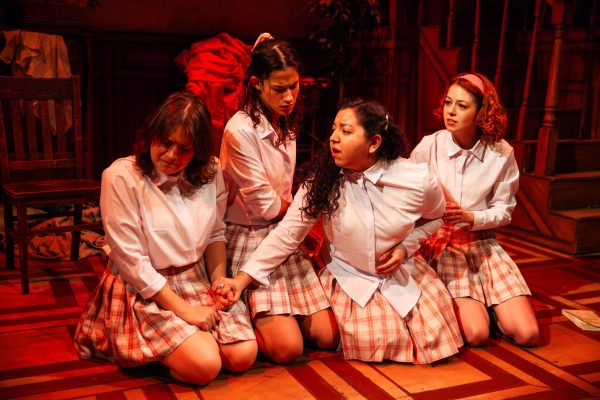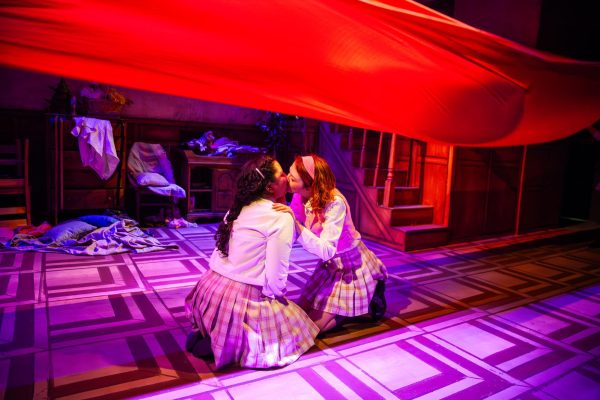It’s hard to add an original spin to Shakespeare, much less to a play as famous as Romeo and Juliet. From the dozens of movies sharing the title to musicals like West Side Story and even to pop songs like “Love Story,” Romeo and Juliet is as over adapted as they come. The audience always knows what to expect with this teenage romance. I, for one, was actually slightly disappointed when I read the play in middle school: isn’t this just a tale about two hormonal teenagers? I gave the two star-crossed lovers a second chance in high school, but the text left me unimpressed once more. It was only with PrideArts’ production that I finally got it.
PrideArts’ production is actually an adaptation of an adaptation. Shakespeare’s R&J is an adaptation of Shakespeare’s original written in 1999 by Joe Calarco, who set the play in an exclusive boys-only prep school. Amber Mandley, who directed PrideArts’ version of Calarco’s script, changed the story to revolve around an all-female cast instead. The four protagonists are girls at a boarding school who sneak out of their dormitories at night to act out Shakespeare’s play. They tackle the initial scenes with comical exaggeration and slapstick, but as the play progresses, they become consumed by the fervor of the romance and the tragedy of Shakespeare’s story.

Shakespeare’s R&J opens with the bedtime prayer routines at a Catholic boarding school. The real story begins only after the lights flicker out. The girls leap out of bed and race each other up and down the stairs to find a place to rehearse in. The first lines of Shakespeare’s play are delivered with such vigor and energy that it becomes almost impossible to take the prologue’s ominous forewarning of “the fearful passage of their death-mark’d love” seriously. Tragedy is reduced to comedy. This raucous excitement carries throughout the first act.
The play’s actresses deliberately present an overblown version of Shakespeare’s original text. Their gestures and speech convey the eagerness that is very much intentional: sexually repressed teenage girls being exposed to Shakespeare for the first time can only appreciate the rhythm and rhyme of its archaic language to a certain extent; the spice and eroticism of the text is far more attention-grabbing. It is very much reminiscent of what reading Romeo and Juliet was like for me in my girls-only middle school—how can you not giggle at your friend who’s pretending to be an innuendo-making, thumb-biting medieval servant?
As the play moves into its second act, things start getting serious. In the balcony scene, likely the most famous single scene from the play, the positions are inverted: Juliet looks up adoringly at her Romeo, while Romeo gazes down at her Juliet from the top of the boarding school stairs that function as a pseudo-balcony. We are reminded once again that this is not meant to be a faithful recreation of the play, but a group of adolescents’ exploration of their identities through the medium of the play. There are no fixed positions or identities in this production; every girl takes on an assortment of roles, and we are expected to fill in the blanks ourselves. Tybalt is the Nurse, Mercutio is Friar Lawrence, and the transitions between these roles are jarring at times. Yet the fluidity of roles—made necessary by the deliberately small cast of four—perfectly encapsulates the timelessness of the play: you do not have to be a Montague or a Capulet to experience the agony of unrequited love.
Mandley’s portrayal of the consummation of Juliet and Romeo’s marriage is also delightfully subtle and tasteful. In stark contrast to the suggestive play-fighting staged during the earlier acts, the two lovers share a kiss under a red veil that symbolizes their desire for each other. The stage is almost silent, providing an air of the serenity and peacefulness that is the trademark of young love. But then the red veil takes on a double meaning as it gradually descends over the lovers: its redness is suggestive of their love, yet it covers them, shielding their lovemaking—and their love—from the audience. It reminded me of the dark velvet curtains that protects the actors standing in the wings of a stage from the scrutiny of their audiences. In this world, the girls choose Romeo and Juliet as their cover, hiding themselves from the judgment and shame of adolescence with a veil of fiction.

Romeo and Tybalt’s sword fight is accorded special attention in this adaptation. During the sequence we revisit the prologue; the girls gather around and chant, “From forth the fatal loins of these two foes/ A pair of star-cross’d lovers take their life.” What started out as a harmless line is now foreboding, marking the imminent chaos and disaster that is set off by Tybalt’s death, which marks the play’s turning point.
From this point on, the girls are wholly consumed by their characters. Romeo is grave and desperate; Juliet is tortured and mournful. The other two girls stand at the side of the stage, but they are equally consumed by their friends’ acting: they hold onto each other, despair palpable as they know that they cannot do anything to reverse the course of the play. Actresses and roles merge into each other. She is Juliet and she is Romeo, and the forbidden love between a Capulet and a Montague is transmuted into the forbidden love between two girls.
This theme lies at the heart of the enduring power of Shakespeare: a forbidden love that transcends time and space, the kind of agony and sorrow that transcends individuals and the “houses” they belong to. Even for a text that could be described as done-to-death, somehow, the audience of PrideArts’ Shakespeare’s R&J walks away with questions still unanswered—what will happen to this fledgling love that blossoms between actresses onstage? Is there any turning back? Once this night is over, what becomes of these four girls?
Shakespeare’s R&J is a production that differs vastly in form from Shakespeare’s original, yet remains deeply faithful to the central themes of the text. Its creative innovations provide a much-needed update to the star-crossed lovers trope and rekindles the embers of forbidden love for a modern audience.
Shakespeare’s R&J ran until March 24, 2024 at Pride Arts Theater.








